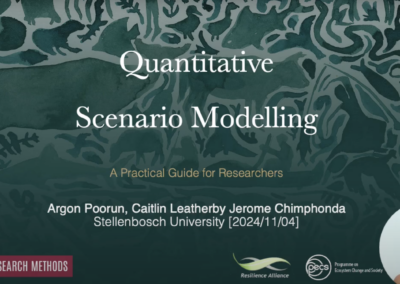This page deals with scenario-development methods which, in global assessments, are used to focus scientific investigation, integrate different models and data, and improve decision-making. Local-scale scenarios often involve participatory processes that enhance stakeholder engagement and legitimacy in decision-making. The content on this page discusses the double uncertainty matrix, Mānoa, scenario archetypes, La Prospective and causal layered analysis.
The Chapter summary video gives a brief introduction and summary of this group of methods, what SES problems/questions they are useful for, and key resources needed to conduct the methods. The methods video/s introduce specific methods, including their origin and broad purpose, what SES problems/questions the specific method is useful for, examples of the method in use and key resources needed. The Case Studies demonstrate the method in action in more detail, including an introduction to the context and issue, how the method was used, the outcomes of the process and the challenges of implementing the method. The labs/activities give an example of a teaching activity relating to this group of methods, including the objectives of the activity, resources needed, steps to follow and outcomes/evaluation options.
More details can be found in Chapter 11 of the Routledge Handbook of Research Methods for Social-Ecological Systems.
Chapter summary:
Biggs, R. (2022)
Method Summaries
Different Types of Scenarios Address Various Types of Decisions
Peterson, G.D. (2022)
Case Studies
Biosphere Futures: a collection of scenario cases
Peterson, G. & Kuiper, J. (2022)
Complexity and scenarios in the Swedish Stockholm-Lake Mälar Region
Svedin, U. & Liljenström, H. (2022)
Futures of human-nature relationships on the high seas: combining topic modelling with creative, structured futuring and science fiction storytelling
Luebker, H.M. (2022)
Lab teaching/ activity
Tips and Tricks
- Alcamo, J. 2008. ‘Environmental Futures: The Practice of Environmental Scenario Analysis.’ Developments in Integrated Environmental Assessment, Volume 2. Amsterdam: Elsevier. doi:10.1016/S1574-101X(08)00406-7.
- Bishop, P., A. Hines, and T. Collins. 2007. ‘The Current State of Scenario Development: An Overview of Techniques.’ Foresight 9(1): 5–25.
- Curry, A. 2012. ‘The Scenarios Question.’ In The Future of Futures, edited by A. Curry. Houston: As-sociation of Professional Futurists.
- Glenn, J.C., and T.J. Gordon. 2009. Futures Research Methods 3.0. Millennium Project. https://www.millennium-project.org/publications-2/futures-research-methodology-version-3-0/.
- Kosow, H., and R. Gaßner. 2008. Methods of Future and Scenario Analysis: Overview, Assessment, and Selection Criteria, Volume 39. In Studies from German Development Institute/Deutsches Institut für Entwicklungspolitik (DIE). http://edoc.vifapol.de/

